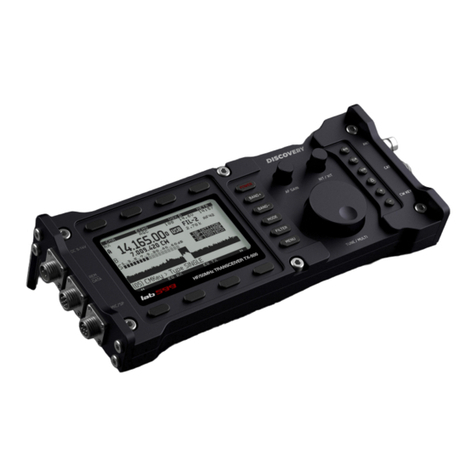
MODE SELECTION
Each mode is described briefly below. Later sections cover each mode in detail. Tap
Done or more times to select USB (LSB), CW (CWR), DIG, AM or FM mode. Long
push selects alternate modes, such as CW reverse (CWR). Also, long push returns
normal mode.
• SSB: Single-Sideband modes are narrow-banded voice modes that conserves
space in crowded band segments. They’re the most popular modes overall, they
are: LSB (lower-sideband) usually used in 160, 80 and 40 meters, while other bands
use USB (upper-sideband).
• CW: Continuous Wave mode requires narrow bandwidth, providing a high signal-
to-noise ratio which is ideal for low-power (QRP) use. It’s also a popular mode for
DXing and contests. CWR Continuous Wave Reverse is the alternate mode, and
may reduce the level of interference (QRM).
• AM: Amplitude Modulation mode is characterised by good delity. It’s much less
power-efcient than SSB modes. You can easily nd AM amateur stations in 160,
80, 40 and 10 meters.
• FM: Frequency Modulation mode is most often used for local communications,
and can be found on 10 m and up.
• DIG: Digital Mode is usually used with a computer connected to the transceiver
to send/receive data. Although SSB modes can also be used for this purpose, the
TX-500’s audio-based data modes (E) optimise settings for data rather that voice.
VFOS A AND B
The TX-500 provides two VFOs. Use of VFO B is optional. Each VFO has independent
frequency, mode, and lter settings:
• VFO A normally controls both the receive and transmit frequency. Most contacts
occur between stations tuned to about the same frequency.
• VFO B can serve as a holding register for a second frequency of interest, then
swapped with VFO A as needed (see A<>B).
•
+ - Tuning rates: Tapping Kor Lselects VFO tuning rate LSB, USB, DIG (10Hz, 100Hz,
1kHz, 2.5kHz, 5kHz), CW, CWR (1Hz, 10Hz, 100Hz, 1kHz, 2.5kHz), AM, FM (100Hz,
500Hz, 1kHz, 2.5kHz, 5kHz). SSB stations often align on 0.5 or 1.0kHz boundaries.
• A->B To copy VFO A’s frequency to VFO B: Tap N>A->B. Tapping also copies
VFO A’s mode and lter settings to VFO B as well.
• B->A To copy VFO B’s frequency to VFO A: Tap N>B->A. Tapping also copies
VFO B’s mode and lter settings to VFO A as well.
• A<>B VFO A and B swap: Tap N>A<>B to exchange VFO frequencies, modes,
and all other settings.
6





























